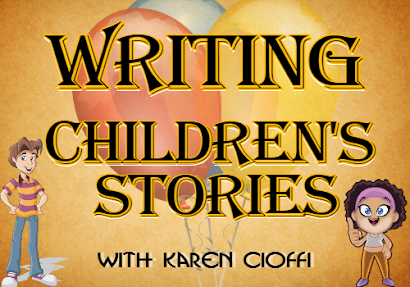Writing can be thought of as a recipe, a handful of plot, a quarter cup of setting, a half cup of dialogue, and a half cup of action and forward movement. Then you also need to add just the right amount of theme, character, setting, and style. Stir it all together and bake for several months (might be longer, depending on your oven), and that’s it.
Ah, if it were only that simple.
Today, there are a number of rules to writing that didn’t plague writers years ago when the world was slower and people actually had time to sit and read at a leisurely pace. Writers had the luxury of setting scenes in detail and didn’t have to worry about ‘telling’ too much.
Now, publishers want your story to begin with a BAM. Grab the reader right away or you’ll lose her. And, it’s important that setting and telling are limited. In addition, don’t forget to magically weave backstory for your characters seamlessly into the mix.
This is especially true for children’s book.
So, what is the right balance of writing elements that will create a successful story?
Well, there really isn’t a pat formula. Each story will call for its own particular amounts of elements, and each publisher will have her own set of rules that the author must adhere to. But there are certain basics that all stories must contain.
The five basic elements of a story are:
Plot: The arrangement of circumstances and/or events in the story, including conflicts and resolution.
Character: Without the main character and supporting characters the plot is useless. It is the character’s struggle to overcome the conflicts or obstacles in his path that gives the plot life.
Setting: This element includes the physical backdrop of the story, the time period and location.
Atmosphere or Tone: The mood, including the setting, characters and their clothing, weather, and other elements within the story, determines the tone of the story.
Style: The author’s way of expressing herself is the style. Sentence structure, diction, choice of words, point of view, imagery, and symbols are all means of conveying a story that is unique to the author.
In regard to the amounts or balance of each element, the objective is to create a story that continually moves forward toward a satisfying conclusion while holding the reader’s attention. You can have a plot driven story or a character driven story. You can also have a story with a lot of dialogue, but you need to be sure the story is focused, coherent, and engaging.
Often, as you self-edit your own work, you won’t be able to see if the elements are just right. To remedy this, you should have it critiqued and have an editor take a look at it to see if you’re on the mark. Then after all that, it will be up to the publisher’s acquisition editor to give the final say on whether you have just the right balance of writing elements for a successful story.
ABOUT THE AUTHOR
Karen Cioffi is an award-winning children’s author and children’s ghostwriter, rewriter, and coach with clients worldwide. She is also the founder and editor-in-chief of Writers on the Move and an author online platform instructor with WOW! Women on Writing.
Karen’s children’s books include Walking Through Walls and The Case of the Stranded Bear. She also has a DIY book, How to Write Children’s Fiction Books. You can check them out at: https://karencioffiwritingforchildren.com/karens-books/. If you need help with your children’s story, visit: https://karencioffiwritingforchildren.com.
A feature in the right column of this blog lets you subscribe to #SharingwithWriters so you don’t miss any of Karen’s posts on writing for children.
MORE ABOUT THE BLOGGER
Howard-Johnson is the multi award-winning author of fiction, creative nonfiction, and poetry. She is also a marketing consultant, editor, and author of the multi award-winning HowToDoItFrugally Series of books for writers including the multi award-winning The Frugal Book Promoter (http://bit.ly/FrugalBookPromoIII), now offered in its third edition by Modern History Press. Carolyn's latest is in the #HowToDoItFrugally Series of books for writers is How to Get Great Book Reviews Frugally and Ethically. She has two booklets in the #HowToDoItFrugally Series, both in their second editions from Modern History Press. Great Little Last Minute Editing Tips for Writers (http://bit.ly/LastMinuteEditsII) and The Great First Impression Book Proposal (http://bit.ly/BookProposalsII) are career boosters in mini doses and both make ideal thank you gifts for authors. The one on writing book proposals is also available as an Audio Book. The Frugal Editor (http://bit.ly/FrugalEditor), now in its second edition, is the winningest book in the series.
Carolyn also has three frugal books for retailers including one she encourages authors to read because it helps them convince retailers to host their workshops, presentations, and signings. It is A Retailer’s Guide to Frugal In-Store Promotions: How To Increase Profits and Spit in the Eyes of Economic Downturns with Thrifty Events and Sales Techniques (http://bit.ly/RetailersGuide).
In addition to this blog, Carolyn helps writers extend the exposure of their favorite reviews at TheNewBookReview.blogspot.com. She also blogs all things editing--grammar, formatting and more--at The Frugal, Smart, and Tuned-In Editor (http://TheFrugalEditor.blogspot.com). Learn more and follow for news on her new releases direct from Amazon at http://bit.ly/CarolynsAmznProfile.



No comments:
Post a Comment
Thank you for commenting on posts at #SharingwithWriters blog, a Writers Digest 101 Best Websites pick at
www.SharingWithWriters.blogspot.com. You might also find www.TheFrugalEditor.blogspot.com full of resources you can use and
www.TheNewBookReview.blogspot.com, a free review site will benefit your book or increase your reading pleasure.